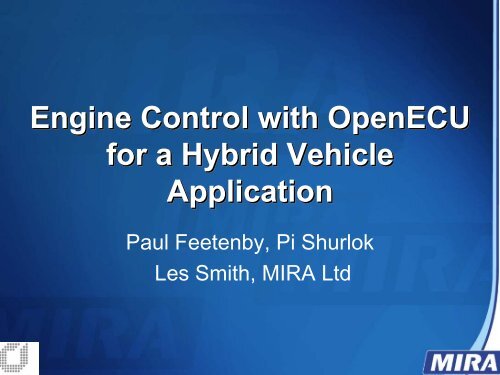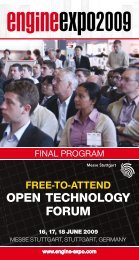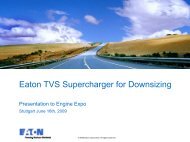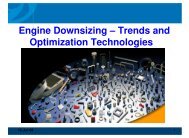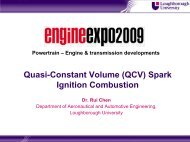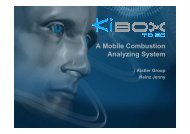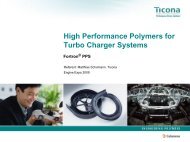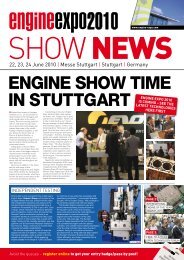Engine Control with OpenECU for a Hybrid Vehicle Application ...
Engine Control with OpenECU for a Hybrid Vehicle Application ...
Engine Control with OpenECU for a Hybrid Vehicle Application ...
- No tags were found...
You also want an ePaper? Increase the reach of your titles
YUMPU automatically turns print PDFs into web optimized ePapers that Google loves.
<strong>Engine</strong> <strong>Control</strong> <strong>with</strong> <strong>OpenECU</strong><strong>for</strong> a <strong>Hybrid</strong> <strong>Vehicle</strong><strong>Application</strong>Paul Feetenby, Pi ShurlokLes Smith, MIRA Ltd
IntroductionEarlier last year MIRA unveiled a new hybrid car developmentcalled H4VProject 50:50 funded by the Energy Saving Trust (EST) andMIRAH4V is a series/parallel petrol-electric hybrid <strong>with</strong> the front axledriven by the engine and the rear axle driven by two electricmotors.The hybrid power train is controlled by a vehicle level controlunit (VCU) communicating via CAN to an ‘open architecture’engine ECUThis presentation focuses on the open architecture feature ofthe engine ECU
H4V <strong>Hybrid</strong> Car
H4V Schematic Layout
Key ObjectivesTo enable ‘fly by wire’ engine control over CAN link <strong>for</strong> the H4VVCUTo reduce engine base fuel consumptionTo shift minimum BSFC to a lower speed – high torque regionTo evaluate the potential benefits of an open architecture ECUstrategy development tool chain
What is an Open ArchitectureECU ?The underlying controller strategy on an engine ECU is‘closed’ i.e. exe only. In general, source code strategy isnever released by the OE to a third partyLimited access to calibrate ECU labels is enabled only toselected Tier 1s by the OEFor H4V these limitations were untenableSolution: use an ‘open’ architecture ECU strategy –<strong>OpenECU</strong> from Pi Shurlok was selected<strong>OpenECU</strong> is a commercially supported open-architectureautomotive controller development tool comprising ECUhardware and software toolbox
Project PlanWork scope broadly divided into four parts:Phase 1 – Modelling and analysisPhase 2 – <strong>Engine</strong> characterisationPhase 3 – Migration to <strong>OpenECU</strong>Phase 4 – Integration of <strong>OpenECU</strong> <strong>with</strong> H4V car
Phase 1 - Modelling & Analysis
GT-Power ModellingModels of the base engine were developed and used <strong>for</strong>parametric studies on:Cam profileValve timing e.g. EMOP-IMOP optimisationPumping work analysis <strong>with</strong> and <strong>with</strong>out EGRIgnition advanceInlet system geometry
Torque<strong>Engine</strong> Per<strong>for</strong>mance PredictionInlet valve phasingEMOP-IMOP optimisation
Phase 2 – <strong>Engine</strong>Characterisation
Work ScopeRemove engine and complete EMS from OE vehicle and mounton engine dynamometerDerive base engine mappings <strong>for</strong> the H4V application
Base <strong>Engine</strong> Mappings
Phase 3 – Migration to
<strong>OpenECU</strong>Open-source engine controllerSimulink strategiesExtensible generic engine control strategySupported by industry standard development tools
Work ScopeConfiguration of <strong>OpenECU</strong> I/O: e.g. ignition coils, fuel injectors,ETB, sensors etc.Develop interface loomFirst-cut calibrationStrategy extensionsCalibration refinement
<strong>OpenECU</strong> Installation
Bespoke Strategy DesignTorque request modeAllows VCU to manage load contributionsAchieved over CAN bus requestSpeed request modeAllows speed matching <strong>for</strong> clutch less transmissionengagementAchieved over CAN bus request
Torque Request ModeTorque request to be issued by the VCU over CAN bus to the<strong>OpenECU</strong> controllerAn estimation model was implemented capable of predicting theneutral load (i.e. no ancillary loads) brake flywheel torque of theengine to <strong>with</strong>in ± 3NmTorque to be limited to an arbitrary ‘safe state’ using an EMSlabel calibrationTorque request requires an electronic throttle body (ETB)Throttle plate motor current to be driven by a PWM output fromthe <strong>OpenECU</strong>
Torque Estimation Model
Torque Response TestDynamometer based – set speed in torque/speed controlFully-warmed engineDemand torque requested over CANDelivered torque measured on engine dynamometerAgreement <strong>with</strong>in tolerance
Torque Response
Torque Limit <strong>Control</strong>Strategy inhibits fuel enrichmentat high loadsOptimal BSFC maintained<strong>Engine</strong> and catalyst durabilityTorque limit control featuregiven authority to limit load toprotect engine and catalyst<strong>Engine</strong> effectively de-rated,deficit made-up by EV mode
Speed Request ModeVCU target engine speed requestSpeed matching <strong>for</strong> clutch less gear changeSpeed elevation <strong>for</strong> alternator power
Plot – speed matching
BSFC Optimisation
Phase 4 – Integration <strong>with</strong> H4V<strong>Vehicle</strong>
Torque Request In-<strong>Vehicle</strong>
SummaryPer<strong>for</strong>mance targets successfully metToolchain and expertise now readily deployable on otherapplicationswww.openecu.comwww.mira.co.uk


